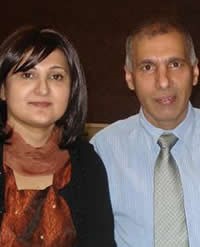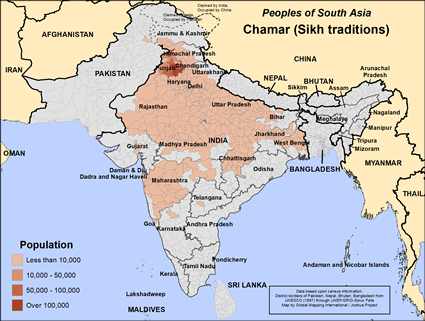Chamar (Sikh traditions) in India

Photo Source:
Balhar Singh
|

Map Source:
People Group data: Omid. Map geography: UNESCO / GMI. Map Design: Joshua Project.
|
| People Name: | Chamar (Sikh traditions) |
| Country: | India |
| 10/40 Window: | Yes |
| Population: | 1,583,000 |
| World Population: | 1,583,000 |
| Primary Language: | Punjabi, Eastern |
| Primary Religion: | Other / Small |
| Christian Adherents: | 0.53 % |
| Evangelicals: | 0.00 % |
| Scripture: | Complete Bible |
| Ministry Resources: | Yes |
| Jesus Film: | Yes |
| Audio Recordings: | Yes |
| People Cluster: | South Asia Dalit - Chamar (Bhambi) |
| Affinity Bloc: | South Asian Peoples |
| Progress Level: |
|
Introduction / History
The Sikh Chamar are Hindus who converted to Sikhism under the teaching of the Ten Gurus who lived from 1469 to 1708. Sikhism teaches that there is no caste system. All men and women are equal in God's eyes. Many of the Hindus who became Sikhs were from a low caste. The original occupation of the Chamar was that of leather worker, a job despised by upper caste Hindus. Later, many Chamar became weavers and landless agricultural workers.
The Sikh Chamar prospered by joining the army during the British colonial period. The Sikh soldiers raised their economic and social status. They became educated and bought land. During WW1 and WW2 many Sikhs fought in the armies of the British Empire. During WW2, Sikh soldiers were instrumental in turning back the invasion of India by the Japanese at the Battle of Kohima.
The two primary languages of the Chamar Sikhs are eastern Punjabi and Hindi. They also speak other regional Indian languages.
Where Are they Located?
The vast majority of the Chamar Sikhs live in the north central Indian state of Punjab. Smaller numbers live in Uttar Pradesh and other regions of India.
What Are Their Lives Like?
Today the Sikh Chamar live diverse lives. Educated Sikhs enjoy middle to upper class positions in Indian cities. Uneducated Sikh Chamar still live in rural villages much like their ancestors.
A Sikh Chamar can marry any other Sikh since one of the basic tenets of Sikhism is rejected of the caste system. Sikhs are monogamous, that is they marry only one spouse. Any male or female Sikh who has undergone the Amrit initiation or baptism can perform their marriages. Child marriage is forbidden. A newly born baby is taken to a Gurdwara or Sikh place of worship for naming. Each Sikh boy is given the name of Singh or lion while the girl receives the name Kaur or princess.
By giving each Sikh the same last name, the 10 Gurus wanted to eliminate the caste system, which is often revealed on one's last name.
The Sikh Chamar are not vegetarians. However, they do not eat pork. Their main foods are rice, other grains, vegetables and fruit.
What Are Their Beliefs?
The first leader of Sikhism, Guru Nanak Dev (1469-1539), taught the equality of all humans and against the caste system. He traveled throughout India to spread his message of one God. He spoke against tyranny, empty rituals and superstition. The nine other Gurus of Sikhism proclaimed the same beliefs. The holy book of the Sikhs is called the Guru Granth Sahib. It is composed of 5867 hymns written by the Ten Gurus. The Sikhs were persecuted by the Muslim Mughals and frequently unite politically with Hindus against Muslims.
What Are Their Needs?
The Sikh Chamar need to hear the life changing gospel of Jesus Christ regardless of their position in Indian society. They need to see that their good works will not save them from the wrath of the Holy God of Scripture. They must see that Jesus in the only Savior.
Prayer Points
Pray for Christian workers needed to sow God's Word into Sikh Chamar families, healing and strengthening households with God's blessings.
Pray for movements to Jesus to sweep through Sikh families, permeating the group from within.
Ask God to deliver families and communities within the Sikh Chamar people from fears that hinder them from embracing His blessings.